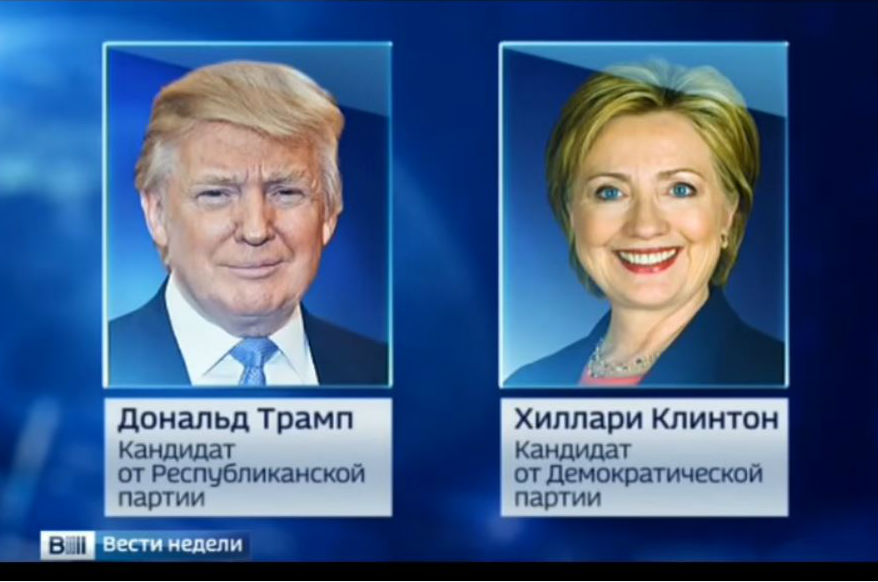 Last year, while Americans were embroiled in one of the ugliest election cycles in recent memory, the Russian media was basking in the phenomenon of Donald Trump.
Last year, while Americans were embroiled in one of the ugliest election cycles in recent memory, the Russian media was basking in the phenomenon of Donald Trump.
The Kremlin was betting that a Trump presidency would be far more advantageous to its interests. Months before the election, Trump had established an agenda that was arguably more anti-NATO than that of Russian President Vladimir Putin. Trump surrogate Newt Gingrich suggested that the United States might not defend Estonia, a NATO ally, if Russia attacked. Trump hinted that he might be willing to lift sanctions and recognize Russia’s annexation of Crimea. At the Republican convention, Trump’s campaign pushed for only a single change in the 35,000 word GOP platform—removing a clause in support of the plan to arm the Ukrainian military to repel its Russian invaders. We now know that Trump pushed for that change around the time that his staffers were meeting with the Russian ambassador to the United States, meetings which the administration denied ever happened until they were leaked to the press.
While Clinton was challenging Russia on several key foreign policy issues, Trump was apparently more willing to take the Kremlin’s line. For instance, as secretary of state, Clinton wanted to stand up to the Assad regime in Syria—clearly not what the Kremlin wanted. Trump, a wealthy real-estate mogul with an affinity for Russia who has a history of cutting deals to make money, was a much more familiar figure. He was critical of the EU, immigration, and NATO—all positions which contrasted with Clinton’s—and harmonized with the Kremlin’s views.
As a result, the Kremlin was likely working hard to help Trump win the election, both through its state-run media outlets and also through more sinister means—the hacking of the Democratic National Committee’s email server.
But as the Atlantic Council’s Ariel Cohen notes, “The shortest honeymoon ever is over.” The Russian military has significantly ramped up its fighting in eastern Ukraine, it continues to strengthen its mission in Syria, and tensions are again mounting between Washington and Moscow. The Russian media has been instructed to reduce its coverage of Trump and to avoid being too complimentary of him. Anti-Americanism is back in vogue.
However, it is a mistake to think that the Kremlin is unhappy with current events. The Russian government’s love affair with Trump had more to do with fostering anti-Americanism than with seeking rapprochement. Russian media coverage reflects this. A careful study of the Kremlin-controlled media, working in both English and Russian, shows that the Russian media was never pro-Trump, but it was anti-Clinton. Trump received mostly neutral treatment, mixed with positive and negative coverage, while the Kremlin spread conspiracy theories and attacked Clinton’s policies. Russian articles about Trump tended to spread the narrative that the United States is a failing democracy and the game was rigged against any politician, like Trump, who did not view Russia as the enemy. They even warned that the establishment would likely find a way to sabotage Trump’s success. In this way, many articles that were “pro-Trump” were really just anti-Clinton, as Clinton was painted as a member of the establishment by both the Russian media and the Trump campaign.
But the Kremlin’s narrative about Trump was formed when Clinton had a commanding lead in the polls. In all likelihood, they never expected him to win. This means that the Kremlin has to find a new narrative to attack the United States. The anti-Americanism that is resurfacing in the Russian media now is just a return to form.
In an interesting twist, the Russian media is now warning that American society is fraying and a constitutional crisis may be brewing. Kiselyov used his TV show on March 5 to voice concern about what is happening in America. Partisanship and controversy are tearing the country apart, he said. “America is in the grips of hatred,” he warned viewers, a situation made more worrisome because of its culture of “free-flowing firearms.”
But don’t let Kiselyov fool you: this is exactly what the Kremlin has been working to achieve. The Kremlin does not need a “reset” with the United States. The Russian military can end the fighting in Ukraine whenever it wants. It could attack ISIS in Syria, or help alleviate the humanitarian crisis and negotiate a political settlement to that crisis. The reality is that the violence in both places is part of the Kremlin’s plan. The Kremlin is comfortable that the United States is so distracted by its own political crisis that events in Syria and Ukraine, which don’t neatly fit into the partisan debates, have fallen out of the headlines.
Though sanctions are hurting Russians, the Putin government has been able to blame its economic hardship on the West. As a result, Putin continues to enjoy high levels of support, while his counterpart in the United States has set records for his “unfavorable” numbers this early into the presidency. A good relationship with the United States would reverse half a decade of Kremlin propaganda campaigns. Instead of justifying detente with the West after years of fostering division, the Kremlin’s propaganda machine can instead point to Washington’s divisive politics as the best example of the failure of the West’s pursuit of “democracy” and “human rights.”
The political division is the realization of the Kremlin’s dream—or perhaps the result of its hard work. The honeymoon is definitely over, but the marriage was a sham.
James Miller is the managing editor of The Interpreter, a daily translation and analysis journal covering the Russian government in both foreign and domestic spheres. He tweets @Millermena.
Image: Dmitry Kiselyov's show on Russian state television shows Republican nominee Donald. J Trump and Democratic nominee Hillary Clinton on March 16, 2016. Credit: Screenshot Вести недели с Дмитрием Киселевым
